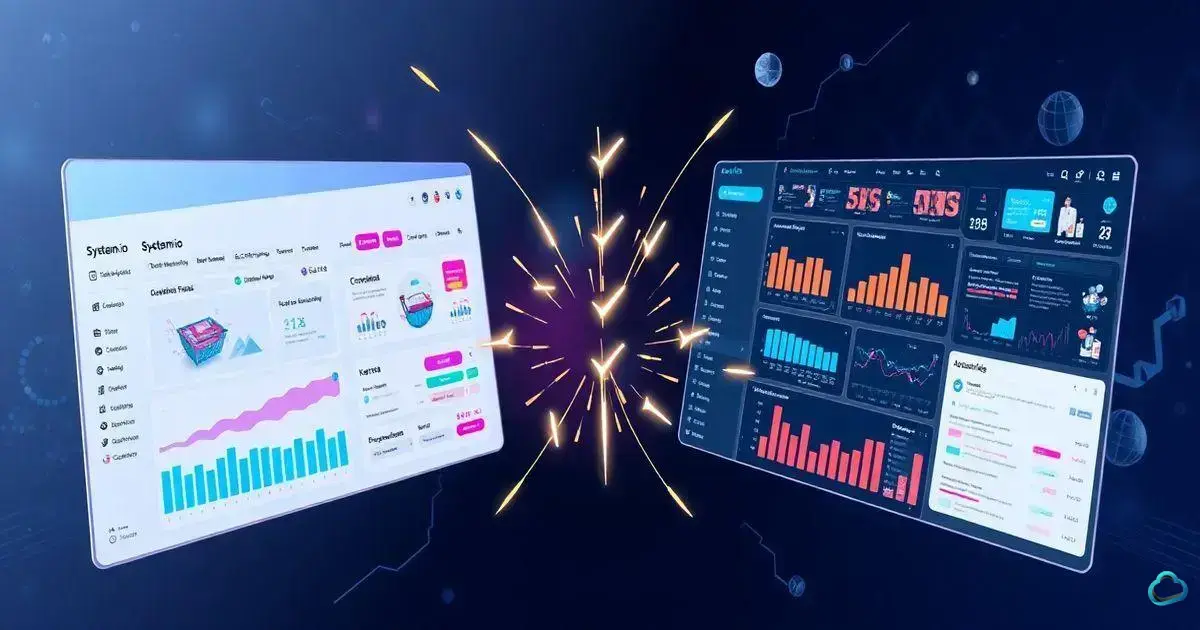Contents
- 1 Understand Your Needs: Identify the essential features and functionalities you require from a SaaS solution.
- 2 Evaluate Pricing Models: Explore different pricing structures such as subscription, pay-as-you-go, and freemium to find the most cost-effective option.
- 3 Consider Scalability: Assess how well a SaaS plan can grow with your business and avoid costs associated with switching providers.
- 4 Investigate Contract Terms: Read the fine print to uncover any hidden fees, cancellation policies, and long-term commitments.
- 5 Leverage Free Trials and Demos: Take advantage of free trials to evaluate software solutions before making a financial commitment.
- 6 Seek Customer Reviews and Comparisons: Research user experiences and expert comparisons to highlight the best value and performance in SaaS offerings.
- 7 Conclusion on Choosing the Right SaaS Plan
- 8 Frequently Asked Questions about Saving Money by Choosing the Right SaaS Plan
- 8.1 What are the key factors to consider when selecting a SaaS plan?
- 8.2 Why is it important to understand my needs before choosing a SaaS solution?
- 8.3 What are some common pricing models for SaaS?
- 8.4 How can I assess the scalability of a SaaS solution?
- 8.5 What should I look for in contract terms for SaaS?
- 8.6 How valuable are free trials and demos in the selection process?
- 8.7 Why is it important to seek customer reviews and expert comparisons?
In today’s digital age, Software as a Service (SaaS) solutions have become essential for businesses and individuals alike. With numerous options available, choosing the right SaaS plan can not only enhance productivity but also significantly reduce costs. This guide will provide you with practical insights on how to assess different SaaS offerings and make informed decisions that empower your financial strategy.
Understand Your Needs: Identify the essential features and functionalities you require from a SaaS solution.
Before diving into the myriad of SaaS options available, it’s crucial to assess and understand your unique requirements. This foundational step can help streamline your decision-making process and ensure that you choose a solution that meets your current and future needs.
Key Points:
List Core Functionalities
Identify the primary functions that are essential for your business operations. Consider what problems you are trying to solve and which features will address those challenges.
Prioritize Must-Have vs Nice-to-Have Features
Differentiate between essential features and those that are merely desirable. Focus on must-have capabilities that will provide immediate value and consider nice-to-have features as future considerations.
Consider User Experience
Evaluate how user-friendly the software is. A solution that is easy to navigate and requires minimal training can save time and increase productivity.
Evaluate Integration Needs
Check if the SaaS solution easily integrates with other tools and systems you already use. Seamless integration can enhance efficiency and streamline operations.
Assess Security Features
Look into the security measures the SaaS provider has in place. Ensure they comply with industry standards and regulations to protect your sensitive data.
Gather Team Input
Consult with your team members who will be using the software to gather insights and feedback about their needs and preferences. This collaborative approach can lead to better alignment and satisfaction with the chosen solution.
Taking the time to thoroughly understand your needs will greatly increase your chances of selecting a SaaS plan that not only meets your requirements but also supports your growth and success. By carefully evaluating and prioritizing features, you’ll be positioned to make a smarter and more cost-effective decision.
Evaluate Pricing Models: Explore different pricing structures such as subscription, pay-as-you-go, and freemium to find the most cost-effective option.

When choosing a SaaS solution, understanding the various pricing models available is crucial for ensuring that you select the most cost-effective option for your needs. Different pricing structures can greatly impact your overall expenditure, making it essential to compare and evaluate them carefully.
Subscription Pricing: Subscription pricing typically involves a recurring fee, charged monthly or annually. This model often includes access to all features and regular updates. Assess whether the subscription cost fits within your budget and consider the value of the features offered.
Pay-As-You-Go Pricing: Pay-as-you-go pricing allows you to pay only for the features or usage you need. This model can be cost-effective for businesses with fluctuating needs, as you won’t pay for unused capacity. Evaluate if this flexibility aligns with your usage patterns.
Freemium Model
The freemium model offers basic features for free while charging for advanced functionalities. This allows you to test the software without financial risk. However, be mindful of the limitations imposed by the free tier and whether they meet your essential needs.
Tiered Pricing: Tiered pricing structures provide different packages at varying price points based on features and usage limits. Assess the tiers to determine which package offers the best balance of features and cost for your organization.
One-Time Fees vs. Recurring Costs: Some SaaS solutions may offer a one-time fee for a perpetual license compared to ongoing subscription costs. Consider the total cost of ownership, including any additional fees for updates, support, or extra features.
Hidden Costs and Additional Fees: Always read the fine print to identify any hidden costs or additional fees associated with the SaaS solution. This can include charges for customer support, training, or exceeding usage limits, which may impact your overall budget.
By carefully evaluating the various pricing models available, you can make an informed decision that best aligns with your budget and operational needs. Always consider both immediate costs and the long-term value of the features provided to ensure a cost-effective SaaS solution.
Consider Scalability: Assess how well a SaaS plan can grow with your business and avoid costs associated with switching providers.
As your business evolves, so do your software needs. A scalable SaaS solution is vital for accommodating growth without incurring unnecessary costs or operational disruptions. Understanding scalability can help ensure that your chosen SaaS plan can expand alongside your business objectives.
Evaluate Growth Potential: Determine if the SaaS solution can handle increased usage, additional features, or more users as your business grows. Research its capacity limits and growth capabilities.
Flexible Package Options: Look for SaaS providers that offer flexible package options or modular features. This allows you to upgrade or add services as needed without a complete plan overhaul.
User Licensing Structure: Consider how user licenses are structured. Some SaaS solutions charge per user, while others offer unlimited access at a fixed rate. Choose a structure that can adapt to your team’s growth.
Integration Capabilities:
Assess the SaaS solution’s ability to integrate with new tools and platforms you may adopt in the future. A solution that supports seamless integrations with existing and future software will facilitate growth.
Performance Consistency: Consider how well the SaaS application maintains performance and responsiveness as you scale. Read reviews and testimonials about performance during high-demand periods.
Support During Transition Phases: Research the level of customer support offered during key transition phases when scaling your operations. Reliable support can make the growth process smoother and less stressful.
Investing in a scalable SaaS solution is crucial for long-term success. By understanding how well a solution can adapt to your growing needs, you can avoid costs and complications associated with switching providers. This strategic approach will empower your business to thrive at any stage of growth.

Before committing to a SaaS solution, it is essential to thoroughly investigate the contract terms. Understanding the fine print can help you avoid unexpected costs and unfavorable conditions down the line. This diligence will ensure that the terms align with your business goals and financial strategies.
Key Points:
1. Understand Payment Structures
Examine the payment terms outlined in the contract. Look for details on billing cycles, payment methods, and any potential fees for late payments or payment processing.
2. Hidden Fees and Additional Costs
Seek out any clauses related to hidden fees, such as costs for exceeding usage limits, additional users, or extra functionalities. Understanding these costs can help prevent budget overruns.
3. Cancellation Policies
Review the cancellation policies to understand how to terminate the service if needed. Some providers may have lengthy notice periods or penalties for early cancellation.
4. Contract Length and Renewal Terms
Pay attention to the duration of the contract and the terms for renewal. Automatic renewals can trap you in an agreement without your explicit consent, so clarify those conditions.
5. Service Level Agreements (SLAs)
Examine the Service Level Agreements, which outline the performance metrics and responsibilities of the service provider. Ensure that SLAs align with your operational requirements and expectations.
6. Legal Clauses and Compliance
Investigate any legal clauses pertaining to liability, dispute resolution, or compliance with regulations. Understanding these terms will provide clarity on the provider’s limitations and your legal rights.
Thoroughly investigating contract terms is crucial for securing a SaaS solution that works for you. By reading the fine print and understanding the implications of the agreement, you can avoid pitfalls that can lead to unexpected costs or legal complications. This careful assessment ensures that you enter into a partnership with the right expectations.
Leverage Free Trials and Demos: Take advantage of free trials to evaluate software solutions before making a financial commitment.
Leverage Free Trials and Demos: Free trials and demos are valuable resources that allow potential customers to explore software solutions without financial commitment. By taking advantage of these opportunities, you can make informed decisions that align with your business’s needs and budget.
Identify Reputable Providers: Start by identifying SaaS providers that offer free trials or demos. Look for reputable companies with a strong track record and positive user reviews to ensure you’re testing quality solutions.
Define Evaluation Criteria: Before starting the trial, establish clear criteria for evaluation. Identify the key features, usability, and performance metrics you want to assess during the trial period.
Engage with Support Teams:
Take advantage of customer support during the trial phase. Ask questions and request assistance to understand how the software works and evaluate the provider’s responsiveness and help resources.
Involve Your Team: Include team members who will use the software in the testing process. Collect feedback from various users to ensure the software meets the needs of everyone involved.
Investigate Limitations: Be aware of any limitations during the free trial, such as restricted features or usage caps. Understanding these constraints will help you evaluate the software’s full potential and identify if paid options are worthwhile.
Assess Long-Term Fit: During the trial, assess how well the software aligns with your long-term goals. Consider whether the solution can scale with your business and if it meets future needs beyond the trial period.
Leveraging free trials and demos is an effective strategy for evaluating software solutions before making a financial commitment. By actively engaging with the software and gathering input from your team during this period, you can make a confident, informed decision that supports your business objectives.
Seek Customer Reviews and Comparisons: Research user experiences and expert comparisons to highlight the best value and performance in SaaS offerings.

Researching customer reviews and expert comparisons is essential for gaining insights into SaaS offerings. By examining user experiences, you can uncover both the strengths and weaknesses of different solutions, helping you make a more informed choice that aligns with your needs.
Utilize Multiple Review Platforms: Explore various review platforms such as G2, Capterra, and Trustpilot. These sites aggregate user opinions and ratings, providing diverse perspectives on different SaaS products.
Look for Verified User Experiences: Focus on reviews from verified users who have hands-on experience with the software. Prioritize feedback from users with similar needs and business sizes to ensure relevant insights.
Identify Common Themes:
Analyze reviews for common themes, both positive and negative. Look for recurring mentions of specific features, ease of use, customer support, and overall satisfaction to gauge the software’s reliability.
Consult Expert Comparisons and Articles: Seek out expert comparisons and articles from reputable technology blogs or industry analysts. These resources will provide in-depth analyses, pros and cons, and recommendations based on a range of criteria.
Assess Response to Feedback: Evaluate how the SaaS provider responds to feedback, both positive and negative. A vendor that actively engages with customers and makes adjustments based on reviews demonstrates commitment to improvement.
Consider the Value Proposition: When comparing services, assess the overall value in relation to pricing, features, and user satisfaction. A higher price doesn’t always mean better quality; consider what you’re actually receiving for your investment.
By seeking customer reviews and expert comparisons, you can gain valuable insights into the performance and value of various SaaS offerings. This research will empower you to make a well-informed choice that best meets your business requirements, enhancing your overall software experience.
Conclusion on Choosing the Right SaaS Plan
Making informed decisions when selecting a SaaS plan is essential for optimizing costs and ensuring alignment with your business needs. By employing the strategies outlined in this guide, you can significantly enhance your chances of finding the most suitable SaaS solution.
Key Tactics
1. Understand your specific needs by identifying essential features and functionalities that will benefit your organization.
2. Evaluate various pricing models to uncover the best financial fit, taking into account subscription, pay-as-you-go, and freemium options.
3. Consider the scalability of the software to ensure it can grow with your business and avoid future costs of switching providers.
4. Investigate the contract terms thoroughly to identify any hidden fees, cancellation policies, and long-term commitments that could impact your bottom line.
5. Leverage free trials and demos to evaluate software performance and suitability before making a financial commitment.
6. Seek customer reviews and expert comparisons to highlight the best value and performance, allowing you to make an informed choice.
Final Thoughts: By following these tactics, you can confidently navigate the SaaS landscape, making choices that not only meet your current needs but also position you for future growth and savings. A strategic approach to selecting a SaaS plan can lead to enhanced productivity, reduced costs, and ultimately, greater success for your business.
Frequently Asked Questions about Saving Money by Choosing the Right SaaS Plan
What are the key factors to consider when selecting a SaaS plan?
Key factors include understanding your specific needs, evaluating different pricing models, considering scalability, investigating contract terms, leveraging free trials and demos, and seeking customer reviews and expert comparisons.
Why is it important to understand my needs before choosing a SaaS solution?
Understanding your needs helps you identify the essential features required for your business operations. This ensures that you select a solution that meets your requirements and avoids paying for unnecessary functionalities.
What are some common pricing models for SaaS?
Common pricing models include subscription pricing (monthly or annually), pay-as-you-go options, freemium models (basic features for free with paid upgrades), and tiered pricing packages based on feature access and user limits.
How can I assess the scalability of a SaaS solution?
Evaluate the SaaS solution’s growth potential, flexible package options, user licensing structure, integration capabilities, performance consistency during high demand, and the level of support during transition phases.
What should I look for in contract terms for SaaS?
When reviewing contract terms, look for payment structures, hidden fees, cancellation policies, contract length and renewal terms, Service Level Agreements (SLAs), and any legal clauses regarding liability and compliance.
How valuable are free trials and demos in the selection process?
Free trials and demos allow you to explore and evaluate the software without financial commitment. They provide an opportunity to test usability, features, and overall fit with your business needs before making a purchase.
Why is it important to seek customer reviews and expert comparisons?
Customer reviews and expert comparisons offer insights into the performance, strengths, and weaknesses of various SaaS offerings. This information can highlight the best value for your investment and inform your decision-making process.






